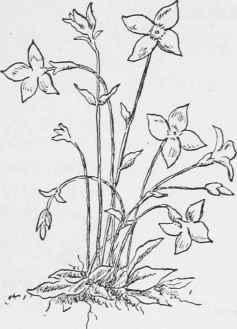Rubiaceae - Madder Family. Bluets. Innocents. Houstonia Cocerulea
Description
This section is from the book "Our Early Wild Flowers", by Harriet Louise Keeler. See also: Newcomb's Wildflower Guide.
Rubiaceae - Madder Family. Bluets. Innocents. Houstonia Cocerulea
Houstonia, named in honor of Doctor William Houston, an early English botanist.
Perennial. Growing in tufts by means of delicate creeping stems, in grassy places both moist and dry. Nova Scotia and Ontario to Michigan, southward to Georgia and Alabama. Abundant in northern Ohio. April-July.
Stem
Smooth, slender, erect, three to six inches high and sparingly branched.
Leaves
Oblong or spatulate, small, opposite.
Flowers
Small, pale blue, lilac, or cream-white, with a yellow eye, solitary.
Calyx
Four-parted.
Corolla
Salver-shaped, with four oval, pointed, spreading lobes that equal the slender tube in length.
Stamens
Four, inserted on the tube of the corolla; variable in position.
Pistil
Ovary two-celled; style variable in length.
Fruit
Capsule; seeds few.
Pollinated by flies, bees, and butterflies. Flowers are dimorphous.
"Innocents, children guileless and frail, Meek little faces, upturned and pale." 213
The number of common names this little plant possesses is evidence that its delicate beauty has appealed to and has won the popular heart. Among its common names are Innocents, Blue-Eyed Babies, and in the neighborhood of Philadelphia it is called Quaker
Ladies. Sometimes the blossoms are called Forget-me-nots, from the tradition prevailing in the country that all small bluish flowers of whatever kind are to be thus designated. Whatever name is given, it is always a caress.
The spreading rootstock sends up a tuft of small leaves from which the slender stems arise and the whole is so delicate that it seems almost like a flowering moss. The blossoms are set on the tip of the stem, where they nod in the bud, but are erect in bloom. In color they fade from sky-blue to white, but the yellow eye remains. The flowers are extremely sensitive to atmospheric conditions; at night and in rainy weather the blossoms bend down, to become erect again when sunshine appears.
The flowers are peculiar in that they are what botanists call dimorphous; that is, some of them have long anthers and a short style, while others have short anthers and a long style. This arrangement for the exchange of pollen secures cross-fertilization.

Bluets. Houstonia coerulea
Continue to:


